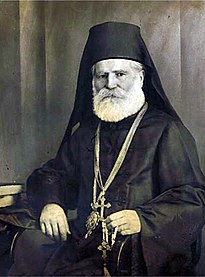Petar Zimonjić (Serbian Cyrillic: Петар Зимоњић; 24 June 1866 – June 1941) was a bishop of the Serbian Orthodox Church serving as the metropolitan of Dabar-Bosnia in the Kingdom of Yugoslavia from 1920 until the beginning of World War II.
Metropolitan Petar of Dabar-Bosna | |
|---|---|
 | |
| Holy hieromartyr | |
| Born | Jovan Zimonjić 24 June 1866 Grahovo, Nikšić, Montenegro |
| Died | June 1941 (aged 74–75) Jasenovac concentration camp, Independent State of Croatia |
| Venerated in | Eastern Orthodox Church |
| Canonized | 1998, Belgrade by Serbian Orthodox Church |
| Feast | 17 September (O.S. 4 October) |
| Attributes | Vested as a bishop |
He was killed by Ustaše of the Nazi Germany-aligned Independent State of Croatia in June 1941.[1][2][3] The Serbian Orthodox Church venerates him as a Saint.
Life
editThe future Metropolitan Petar was the son of a nobleman (vojvoda) and priest Bogdan Zimonjić from the region of Herzegovina. He was born in Grahovo on 24 June 1866. He attended the seminary in Reljevo (in neighboring Sarajevo) between 1883 and 1887 and continued his education at the Orthodox Theological Faculty in Cernovice from 1887 until his graduation in 1893. In October 1893, Petar was appointed assistant professor at the Reljevo Seminary, and a year later he was appointed professor.
He received the name Petar when he took monastic vows on 6 September 1895. He was ordained deacon on 7 September and presbyter the following day. He became a consistorial advisor in Sarajevo in 1901. He was then elected the Bishop of the Eparchy of Zahumlje and Herzegovina and then on 9 June 1903, Petar was consecrated and enthroned in Mostar. After the retirement of the Metropolitan of Dabar-Bosna Evgenije (Letica), Petar was appointed Metropolitan of the diocese by a royal charter dated 7 November 1920.
Martyrdom
editAfter World War II had broken out, Metropolitan Petar was advised to leave Bosnia and move to Serbia or Montenegro. He replied saying: “I am the people's shepherd, which means that I am bound to stay here and share evil with these people, as I used to share well with them; thus I have to share the destiny of my people and stay where I am supposed to be". He defended consistently the Orthodox faith in front of German Gestapo by insisting on continuing use of the Serbian Cyrillic alphabet instead of changing to the Latin alphabet. A Roman Catholic priest, Božidar Bralo, an adherent of the Croatian Ustaše in charge of Bosnia and Herzegovina, had a decisive role in this severe policy of forbidding the use of the Cyrillic alphabet, including the arrest of Metropolitan Petar.[4]
Metropolitan Petar was arrested on 12 May 1941. He was imprisoned first in the Beledija prison, and then three days later he was transported to the Kerestinec camp where he was assigned the number 29781. There, his beard and hair were shaved and all his bishop's insignia were taken away from him. The circumstances of his death are inconsistent. After enduring severe torture, he was moved to Koprivnica and then to either Jasenovac or Gospić concentration camp. According to the testimonies of Jovo Furtula and Jovo Lubura from the Sarajevo District, Metropolitan Petar was killed in the Jasenovac concentration camp.[5] His corpse was then thrown to the fiery furnace used for brick making. However, another version states that Metropolitan Petar was taken to the Jadovno concentration camp,[6] where he was killed in a monstrous manner and his remains were thrown to an acid pit.
In 1998, during the regular session of the Holy Synod of the Serbian Orthodox Church Metropolitan Petar was canonized[7] and his name was added to the list of other saints of the Serbian people and of Orthodox Christian faith. The Serbian Church marks the memory of him in the third week of September.
See also
editReferences
editSources
edit- Content in this draft was copied from Petar (Zimonjić) of Dabar-Bosna - OrthodoxWiki at the OrthodoxWiki, which is licensed under the GNU Free Documentation License as used by Wikipedia and the Attribution-ShareAlike Creative Commons License, Version 2.5 or any later version published; with no Invariant Sections, no Front-Cover Texts, and no Back-Cover Texts. Subject to disclaimers.
Footnotes
edit- ^ "Protodeacon Vladimir Vasilik. The Role of the Roman Catholic Church in the Genocide of Serbs on the Territory of the "Independent State of Croatia"". OrthoChristian.Com. Retrieved 2019-08-26.
- ^ Greble, Emily (2011-02-25). Sarajevo, 1941–1945: Muslims, Christians, and Jews in Hitler's Europe. Cornell University Press. p. 70. ISBN 9780801461217.
Petar Zimonjić.
- ^ Lees, Michael (1992). The Serbian Genocide 1941-1945. Serbian Orthodox Diocese of Western America.
- ^ Rivelli, Marco Aurelio (1998). Le Genocide Occulte (in French). L'AGE D'HOMME. ISBN 9782825111529.
- ^ "[Projekat Rastko] Velibor V. Dzomic: Ustaski zlocini nad srpskim svestenicima (Stradanje srpskih episkopa u NDH)". www.rastko.rs. Retrieved 2019-11-27.
- ^ Peršen, Mirko (1990). Ustaški logori (in Croatian). Globus. ISBN 9788634305470.
- ^ Religion in Eastern Europe. Ecumenical Press, Temple University. 2001.